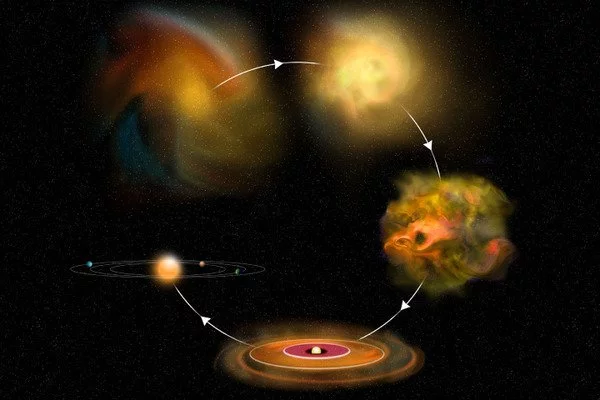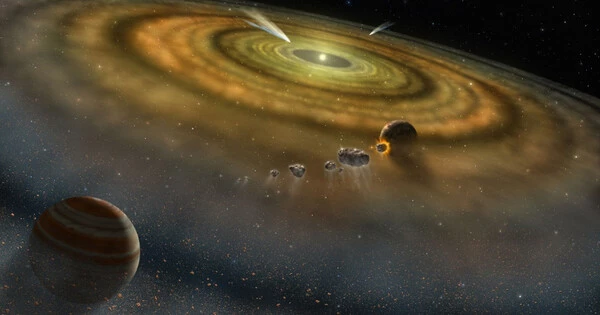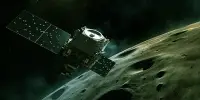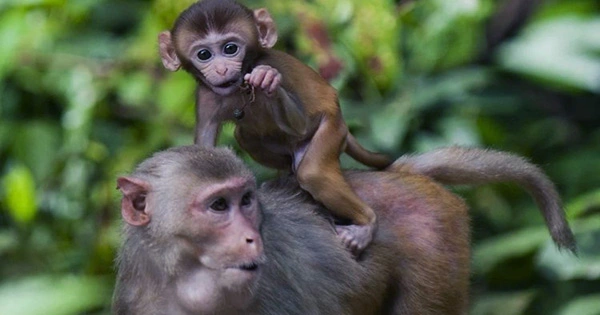Seth Jacobson of Michigan State University and colleagues from China and France have proposed a new theory that could help solve a galactic mystery about how our solar system evolved. How did the gas giants – Jupiter, Saturn, Uranus, and Neptune – end up in their current orbits around the sun?
The findings have implications for how terrestrial planets like Earth formed, as well as the possibility of a fifth gas giant lurking 50 billion miles out in space.
“Our solar system hasn’t always looked the way it does now. Planetary orbits have changed dramatically throughout history “said Jacobson, an assistant professor in the Department of Earth and Environmental Sciences at the College of Natural Sciences. “But we can figure out what happened.”
The study, published in the journal Nature, provides an explanation for what happened to gas giants in other solar systems and our own.
It’s a Nice model
Massive, swirling clouds of cosmic gas and dust give birth to stars. The early solar system was still filled with a primordial disk of gas when our sun ignited, and it played an important role in the formation and evolution of the planets, including the gas giants. Scientists began to believe in the late twentieth century that the gas giants initially circled the sun in neat, compact, evenly spaced orbits. Jupiter, Saturn, and the others, on the other hand, have long settled into orbits that are oblong, askew, and spread out.
So the question for researchers now is, why?
In 2005, an international team of scientists proposed an answer to that question in a trio of landmark Nature papers. The solution was originally developed in Nice, France and is known as the Nice model. It posits that there was an instability among these planets, a chaotic set of gravitational interactions that ultimately set them on their current paths.
“This was a tectonic shift in how people thought about the early solar system,” Jacobson said.
The Nice model remains a leading explanation, but scientists have discovered new questions to ask about what causes the Nice model instability over the last 17 years.
It was once thought that the gas giant instability occurred hundreds of millions of years after the dispersal of the primordial gas disk that gave birth to the solar system. However, newer evidence, including some discovered in moon rocks recovered by the Apollo missions, suggests it happened faster. This raises new questions about how the Earth’s interior solar system evolved.
Working with Beibei Liu from Zhejiang University in China and Sean Raymond from the University of Bordeaux in France, Jacobson has helped find a fix that has to do with how the instability started. The team has proposed a new trigger.
“I think our new idea could really relax a lot of tensions in the field because what we’ve proposed is a very natural answer to when did the giant planet instability occur,” Jacobson said.
Our solar system hasn’t always looked the way it does now. Planetary orbits have changed dramatically throughout history. But we can figure out what happened.
Asst. Professor Jacobson
The new trigger
Raymond and Jacobsen had a conversation in 2019 that sparked the idea. They hypothesized that the gas giants’ current paths were determined by how the primordial gas disk evaporated. That could explain why planets spread out much earlier in the evolution of the solar system than the Nice model originally proposed, and possibly even without the instability to push them there.
“We questioned whether the Nice model was really required to explain the solar system,” Raymond said. “We proposed that the giant planets could spread out due to a’rebound’ effect as the disk dissipated, possibly without ever becoming unstable.”
Raymond and Jacobsen then contacted Liu, who pioneered the rebound effect concept through extensive simulations of gas disks and large exoplanets (planets in other solar systems that orbit close to their stars).
“The situation in our solar system is slightly different because Jupiter, Saturn, Uranus, and Neptune are distributed on wider orbits,” Liu explained. “After a few iterations of brainstorming sessions, we realized that the problem could be solved if the gas disk dissipated from the inside out.”
According to Raymond, the team discovered that this inside-out dissipation provided a natural trigger for the Nice model instability. “We ended up strengthening rather than destroying the Nice model,” he explained. “This was a fun example of putting our preconceived notions to the test and following the results wherever they lead.”
The picture at the start of the instability remains the same with the new trigger. A nascent sun is still surrounded by a cloud of gas and dust. In neat, compact orbits through that cloud, a handful of young gas giants revolve around the star.

“Every solar system begins as a disk of gas and dust. It’s a byproduct of how stars form “According to Jacobson. “However, as the sun begins to burn its nuclear fuel, it emits sunlight, heating up the disk and eventually blowing it away from the inside out.”
This caused a growing hole in the gas cloud, centered on the sun. As the hole expanded, its edge swept through the orbits of the gas giants. According to the team’s computer simulations, this transition is very likely to result in the required giant planet instability. When compared to the original Nice model’s timeline of hundreds of millions of years, the process of shifting these large planets into their current orbits is also fast.
“The instability occurs early as the sun’s gaseous disk dissipates, which is constrained to be within a few million years to ten million years after the solar system’s birth,” Liu said. The new trigger also causes material from the outer solar system to mix with material from the inner solar system. According to Earth’s geochemistry, such mixing must have occurred while our planet was still forming.
“This process is going to really shake up the inner solar system, and Earth can grow as a result of that,” Jacobson said. “That corresponds to my observations.” The group’s future research will focus on the relationship between instability and the formation of the Earth.
Lastly, the team’s new explanation also holds for other solar systems in our galaxy where scientists have observed gas giants orbiting their stars in configurations like what we see in our own. “We’re just one example of a solar system in our galaxy,” Jacobson said. “What we’re showing is that the instability occurred in a different way, one that’s more universal and more consistent.”
Planet 9 from outer space
Although the team’s paper does not emphasize it, Jacobson believes the work has implications for one of our solar system’s most popular and occasionally heated debates: How many planets are there?
The current answer is eight, but the Nice model works slightly better when the early solar system had five gas giants rather than four. Unfortunately, that extra planet was hammer-thrown from our solar system during the instability, which aids the remaining gas giants in finding their orbits.
However, Caltech researchers discovered evidence in 2015 that there may still be an undiscovered planet circling the solar system 50 billion miles from the sun, about 47 billion miles farther out than Neptune. There is still no concrete proof that this hypothetical planet, dubbed Planet X or Planet 9, or the Nice model’s “extra” planet exist. But, if they do, could they be the same thing?
Jacobson and his colleagues couldn’t directly answer that question with their simulations, but they could do the next best thing. Knowing that their instability trigger accurately reproduces the current picture of our solar system, they could test whether their model works better with four or five gas giants.
















